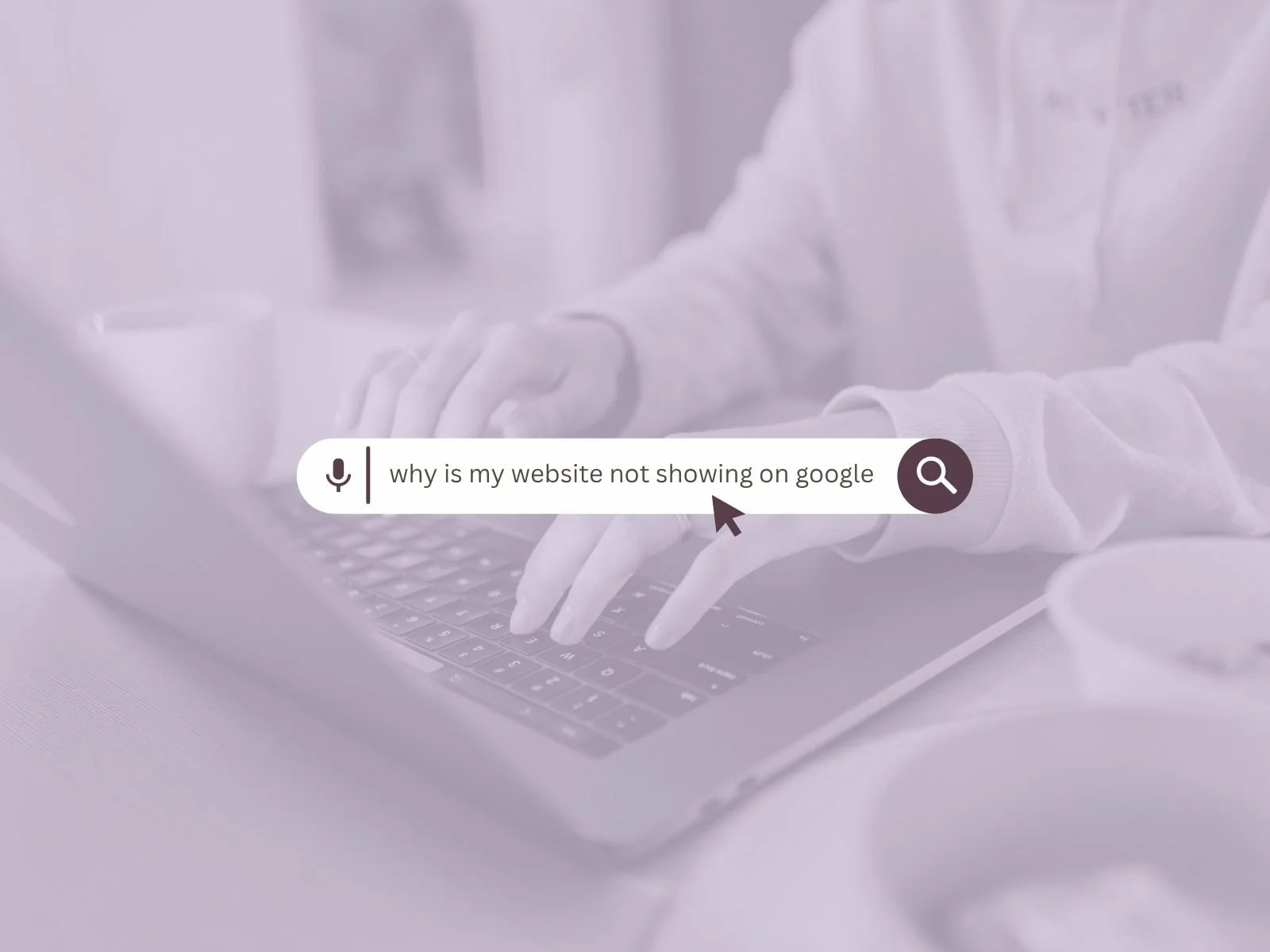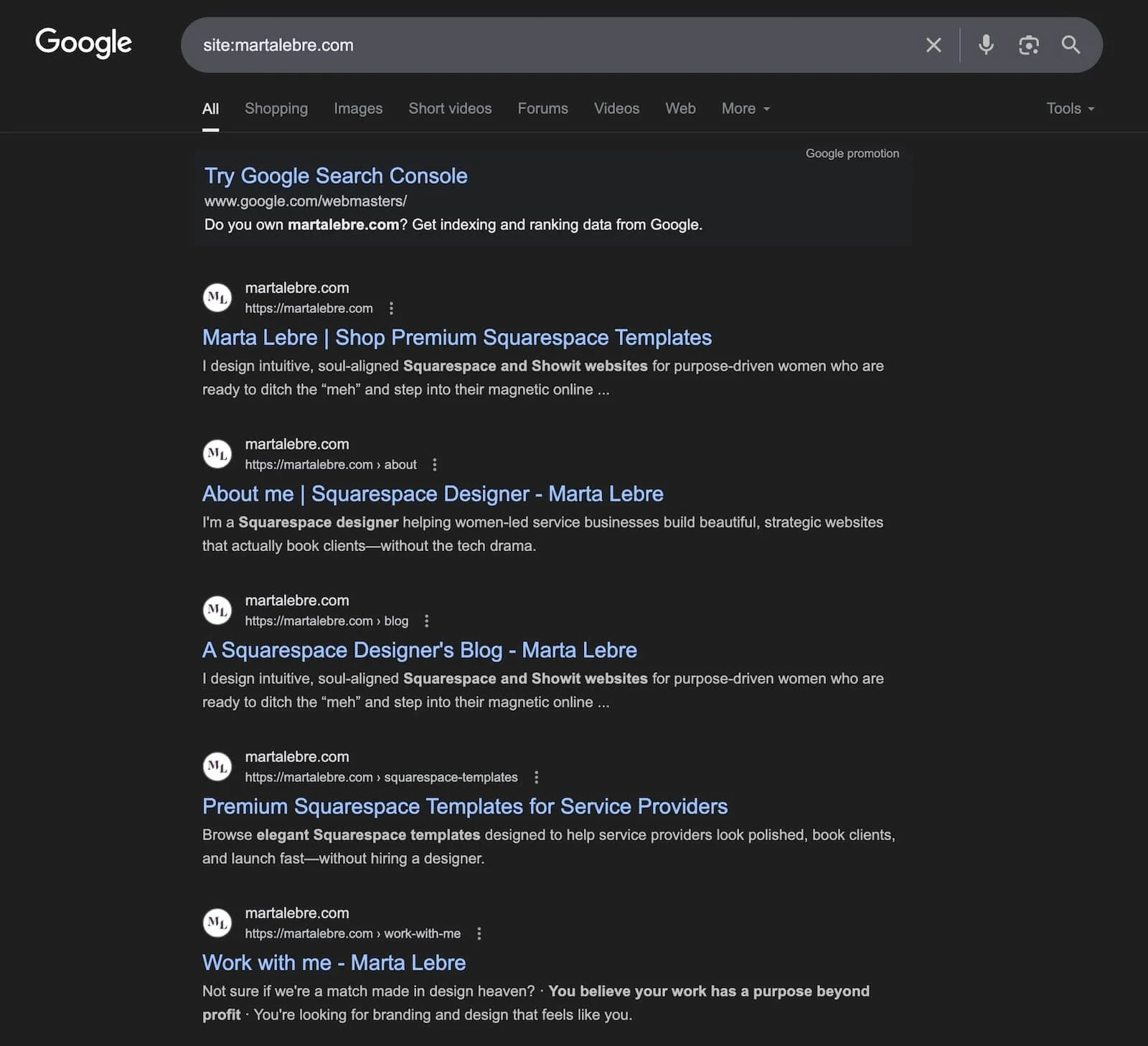Why Is My Website Not Showing on Google? Here’s How to Fix It, Even If You’re Not Techy!
So you built your website (go you!)—you picked the perfect font, wrote heartfelt copy, maybe even added a few sparkly testimonials... and now you're staring at Google wondering:
"How can I make my website appear on Google?"
You're not alone. In fact, one of the most common questions I hear from new entrepreneurs is: Why is my Squarespace website not showing up on Google search?
And here's the truth: it's not you. It's just that Google needs a little nudge. A few breadcrumbs. A warm cup of digital tea to say, "Hey friend, my site is ready to be seen."
Let me walk you through exactly how to make your website show up in Google search — no jargon, no overwhelm.
Table of Contents
🔍 First, Is Your Website Even on Google?
Let’s test it! Head to Google and type:
site:yourdomain.com(Replace "yourdomain.com" with your actual domain name.)
This is a simple way to check if Google knows your site exists. If you see results pop up — that means your site is indexed (which is Google-speak for “we know this site exists and have saved it in our giant database”). If you see nothing — no pages at all — it means Google hasn’t found your site yet. Totally fixable, and we’ll get to that.
⚠️ Possible Reasons Why Your Website Is Not Showing in Google Search
Here are the most common reasons Google is giving you the cold shoulder:
1. You just launched
If your site is brand new, Google might not have found it yet. Google sends out little bots (called “crawlers”) that scan the web for new pages. But unless you’ve submitted your site directly to Google or have links pointing to it, it might take days — even weeks — for the bots to discover you.
2. Your site isn't verified in Google Search Console
Google Search Console is a free tool that tells Google, “Hey! I own this website.” Until you set it up, Google won’t know for sure who owns the site — and it may take longer to index.
3. You don’t have a sitemap submitted
A sitemap is basically a list of all the pages on your website. Submitting it to Google is like handing them a table of contents so they don’t miss anything.
4. There's a "noindex" tag hiding your pages
This one’s sneaky! Many website builders (like Squarespace, Showit, or Wix) include a “noindex” setting on each page. If it’s turned on, it literally tells Google: “Don’t show this in search results.” Sometimes it’s on by default. Whoops!
5. Your domain isn’t connected
If you published your site but you’re still using something like yourname.squarespace.com instead of a custom domain like yourname.com, Google will see it as a sub-site of Squarespace. This doesn’t look professional — and you won’t rank well until you connect your own domain.
6. You don’t have any backlinks yet
Backlinks = links from other websites that point to yours. Google sees them as votes of confidence. No backlinks? Google might not trust your site just yet.
7. Google doesn’t know what your site is about
If your site doesn’t use clear language about what you do, who you serve, and where you’re based (if location matters), Google won’t know what search results to put you in.
8. Your mobile experience is poor
More than half of searches happen on phones. If your site looks janky or doesn’t load well on mobile, Google won’t prioritize it.
9. Your pages load too slowly
People bounce off slow websites fast — and Google knows it. If your site is taking 5+ seconds to load, it may be hurting your rankings.
🚀 How to Make Your Website Come Up on Google (The Gentle Step-by-Step Way)
Here’s exactly how to fix it:
1. Verify Your Site with Google Search Console
This is like waving a giant flag that says, “Hi Google! This site is real. Please index it.”
Go to Google Search Console
Click “Start Now” and sign in with your Google account
Add your website URL
Depending on your website builder, you’ll get instructions for how to verify — usually by pasting a little code into your site settings. (Don’t worry, they’ll walk you through it step by step!)
2. Submit Your Sitemap
Once your site is verified, submit your sitemap so Google knows where everything is.
Go to the “Sitemaps” section in Search Console
Type
/sitemap.xmlafter your domain (likeyourdomain.com/sitemap.xml)Click submit. Done!
Your sitemap is often created automatically by your website platform, so you don’t have to manually build anything.
3. Make Sure Nothing Is Blocking Google
Head into your website settings (check each page!) and look for any SEO or advanced options that say “Hide from search engines” or “noindex.” Make sure those boxes are NOT checked.
Also — Search Console will alert you if your robots.txt file (a hidden tech file that tells Google what to crawl) is blocking anything.
4. Use Keywords You Actually Want to Rank For
Think about what your dream client would actually type into Google when looking for you.
Instead of just “coach” or “designer,” use longer, more specific phrases (called long-tail keywords):
“How to make my website show on Google”
“Brand strategist for wellness entrepreneurs”
“Virtual assistant for holistic businesses”
Where to place them:
In your page titles (what shows in the Google tab)
In your main headline (called an H1)
In your first paragraph
In your meta descriptions
5. Make Sure You’re on a Real Domain
If your site is still using a temporary or platform-branded domain (like yourname.squarespace.com), Google will not take it seriously. Invest in a custom domain — it's usually under $20/year — and connect it through your site settings.
This one step instantly gives your site credibility with both search engines and potential clients.
6. Write for Humans, Not Robots
Google’s bots are smart, but not that smart. They want to see content that’s written for real people — clear, helpful, and authentic.
Instead of trying to “SEO-hack” your content, just:
Answer common client questions
Use natural language (how you’d say it out loud)
Add a FAQ block to every services page
7. Get Some Backlinks
If no one on the internet is linking to your site, Google won’t see you as trustworthy yet. Backlinks don’t have to be fancy.
Try this:
Post your website link on Instagram and Pinterest
Join Facebook groups and drop your link when relevant
Guest blog or do podcast swaps with biz besties
Submit to directories like HoneyBook or The Dieline (depending on your niche)
8. Speed & Mobile Matter
Your site needs to look amazing and load quickly on a phone.
Run a test here: Google PageSpeed Insights
Then try: Mobile-Friendly Test
If your scores are low:
Resize images (less than 500KB per image is a good rule of thumb)
Avoid too many animations or big background videos
Use built-in features rather than third-party code when possible
🤖 And Now... Let’s Talk AI Search
You may have noticed that Google’s search results are starting to look... different. That’s because of AI Overviews — Google’s way of using AI to answer questions right on the search page.
This means:
People may not click on links as much
AI might summarize content instead of sending visitors to your site
BUT — your content can still show up in those answers.
How to Show Up in AI Search Results:
Add clear, concise answers to common questions on your site
Use headings like “How much does [your service] cost?” or “What is a [your niche] coach?”
Keep your tone friendly and conversational
Make sure your About page and Services pages are detailed and specific
Use structured content like FAQ blocks, bullet points, and subheadings
Keep your content fresh — update things like pricing, location, testimonials, and offers
Use schema markup
AI needs well-written, human-friendly content to pull from — and that’s exactly what you’re already great at.
🙌 Final Words: You Didn’t Mess Up
If you’re sitting there thinking, “Why is my website not showing on Google? Did I do something wrong?” let me lovingly tell you:
No. You didn’t.
You made something beautiful. Now you’re learning how to help it be seen.
Google might feel like a mysterious black box, but it really just wants to know:
Who are you?
Who do you serve?
Can you help them?
Answer those questions clearly, and you’ll get found. Promise.
Need help? I offer 1:1 support for women entrepreneurs who are ready to stop hiding and start shining online. Book a free discovery call here → or read more about hiring a Squarespace SEO Specialist.
Interested in Squarespace and SEO? Read also…


